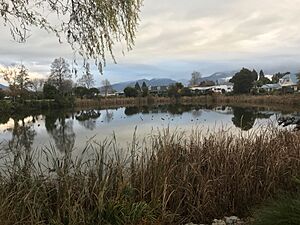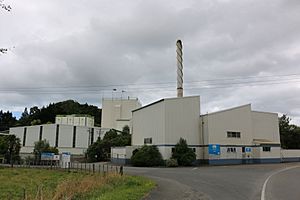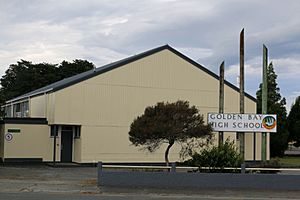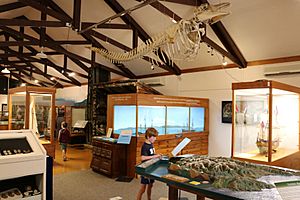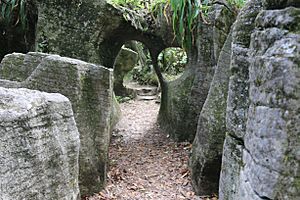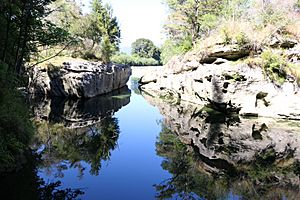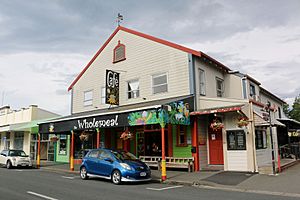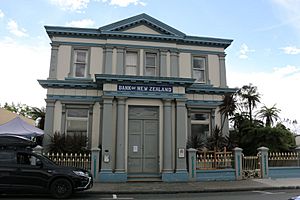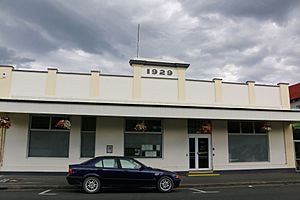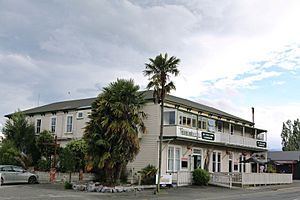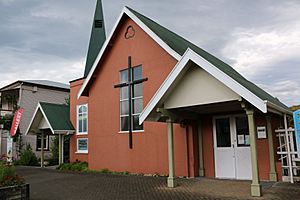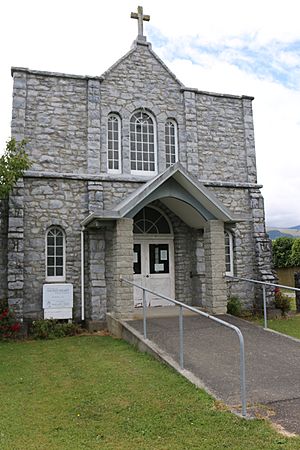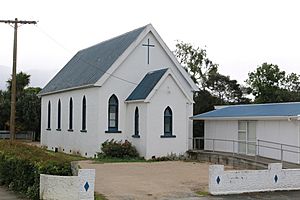Tākaka facts for kids
Quick facts for kids
Tākaka
|
|
|---|---|
|
Town
|
|
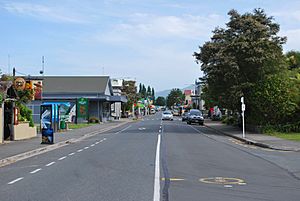
Commercial Street (State Highway 60), the main street of Tākaka
|
|
| Country | New Zealand |
| Territorial authority | Tasman |
| Ward | Golden Bay Ward |
| Community | Golden Bay Community |
| Electorates |
|
| Area | |
| • Total | 12.52 km2 (4.83 sq mi) |
| Population
(June 2023)
|
|
| • Total | 1,390 |
| • Density | 111.0/km2 (287.5/sq mi) |
| Time zone | UTC+12 (New Zealand Standard Time) |
| • Summer (DST) | UTC+13 (New Zealand Daylight Time) |
| Postcode |
7110
|
Tākaka is a small town in New Zealand. It is located at the end of Golden Bay, on the northern tip of the South Island. The town sits by the Tākaka River.
State Highway 60 goes through Tākaka. This road follows the river valley and then climbs over Tākaka Hill. It connects Golden Bay to Motueka, which is about 57 kilometers away. This links Tākaka with the busier coast of Tasman Bay. The town also has its own airport, called Tākaka Aerodrome.
Contents
History of Tākaka
The area where Tākaka is located has been home to Māori for a very long time. One of the early groups was Ngāti Tūmatakōkiri. Later, Ngāti Apa lived here. Today, the main Māori groups (called iwi) in the area are Manawhenua ki Mohua Ngāti Tama, Ngāti Rarua, and Te Āti Awa. These iwi moved from the North Island in the 1820s.
The name Tākaka might come from Taha'a island in French Polynesia. There's a local story about a mythical creature called a taniwha in the nearby Parapara River. This story is similar to one told about a strait near Taha'a island.
From 1853 to 1876, Tākaka was part of the Nelson Province. In the 1870s, cutting timber was a big business in Tākaka. A special railway, called the Takaka Tramway, was built in 1880. Before this, timber was pulled to the port by teams of strong oxen. These teams often left the main street of Tākaka very muddy and uneven.
In 1904, a flood badly damaged the tramway. It was sold in 1905, and its train, wagons, and tracks were sent away by sea.
People from Tākaka also served in wars. One person from Tākaka lost their life in the Boer War. Forty-four people from Tākaka died in the First World War, and 25 in the Second World War.
The Onetahua Kokiri Marae (Manawhenua ki Mohua) is a special meeting place for Māori. It was set up in Pohara Valley in 1986. In 2001, a meeting house named Te Ao Marama was opened there. The name Te Ao Marama is also used for Farewell Spit. The Te Ātiawa iwi say that Onetahua is connected to their ancestors through the Tokomaru canoe, the Parapara mountain, and the Waikoropupu river.
In June 2005, a large fire happened at Tākaka's biggest factory, a dairy factory. Many people in the town had to leave their homes for a short time. There were worries that chemicals stored at the factory might explode and release dangerous gases. Luckily, these fears were not true.
In July 2020, the official name of the town was changed to Tākaka by the New Zealand Geographic Board.
Geography of Tākaka
The area around Tākaka Hill has a special type of rock called karst. This rock creates natural holes in the ground called sinkholes and large cave systems. One of these is Harwoods Hole, which is New Zealand's deepest vertical shaft. Lake Killarney in Tākaka is a sinkhole that has filled up with water from underground.
Tākaka and Golden Bay are famous for rock climbing, especially around a place called Paines Ford.
The town is also known for Te Waikoropupū Springs. These are very clear springs, often called Pupu Springs.
The exact opposite side of the Earth from Tākaka is the town of Coriscada in Portugal. This is called its antipode.
Climate in Tākaka
Tākaka is one of the warmest places in the South Island. This is because it is located far north and is close to the sea in Golden Bay.
Because of the hills in the Kahurangi National Park to the southwest, Tākaka gets less rain than the West Coast. The wind coming over these hills becomes warmer and drier as it blows towards the town. This means Tākaka has about 22 days a year where the temperature goes above 26.7 °C (80 °F). However, because the town is a few kilometers inland, cold air can settle there on winter mornings. This leads to about 17 frosty days each year.
| Climate data for Takaka (1991–2020) | |||||||||||||
|---|---|---|---|---|---|---|---|---|---|---|---|---|---|
| Month | Jan | Feb | Mar | Apr | May | Jun | Jul | Aug | Sep | Oct | Nov | Dec | Year |
| Mean daily maximum °C (°F) | 23.4 (74.1) |
23.3 (73.9) |
21.4 (70.5) |
18.8 (65.8) |
16.5 (61.7) |
14.2 (57.6) |
13.4 (56.1) |
14.0 (57.2) |
15.7 (60.3) |
17.8 (64.0) |
19.4 (66.9) |
21.5 (70.7) |
18.3 (64.9) |
| Daily mean °C (°F) | 17.4 (63.3) |
17.4 (63.3) |
15.7 (60.3) |
13.3 (55.9) |
10.9 (51.6) |
8.6 (47.5) |
7.9 (46.2) |
8.6 (47.5) |
10.2 (50.4) |
12.1 (53.8) |
13.8 (56.8) |
16.1 (61.0) |
12.7 (54.8) |
| Mean daily minimum °C (°F) | 11.4 (52.5) |
11.6 (52.9) |
10.0 (50.0) |
7.8 (46.0) |
5.4 (41.7) |
3.1 (37.6) |
2.4 (36.3) |
3.3 (37.9) |
4.7 (40.5) |
6.5 (43.7) |
8.2 (46.8) |
10.7 (51.3) |
7.1 (44.8) |
| Average rainfall mm (inches) | 141.8 (5.58) |
106.0 (4.17) |
133.8 (5.27) |
164.3 (6.47) |
178.5 (7.03) |
201.2 (7.92) |
178.2 (7.02) |
185.8 (7.31) |
180.7 (7.11) |
209.6 (8.25) |
144.2 (5.68) |
191.0 (7.52) |
2,015.1 (79.33) |
| Mean monthly sunshine hours | 251.6 | 223.4 | 213.6 | 174.4 | 163.6 | 143.3 | 156.9 | 171.7 | 183.9 | 221.5 | 237.5 | 225.7 | 2,367.1 |
| Mean daily daylight hours | 14.7 | 13.7 | 12.3 | 11.0 | 9.9 | 9.3 | 9.6 | 10.6 | 11.8 | 13.2 | 14.4 | 15.1 | 12.1 |
| Percent possible sunshine | 55 | 58 | 56 | 53 | 53 | 51 | 53 | 52 | 52 | 54 | 55 | 48 | 53 |
| Source 1: NIWA | |||||||||||||
| Source 2: Weather Spark | |||||||||||||
Economy and Industries
The main jobs and businesses in Tākaka are farming, cutting timber (sawmilling), digging for limestone (quarrying), and tourism. The area around Tākaka has many minerals. You can find gold, iron ore, copper, silver, and asbestos here. However, not all of these are found in large enough amounts to be worth digging up.
Dairy Factory
There is a Fonterra factory in Tākaka. This factory makes skim milk powder. About 83 dairy farms supply milk to the factory. It can process about 525,000 liters of milk each day. Cream is also made there, and it is sent to another factory for more processing.
The Tākaka dairy factory was damaged by a fire in 2005. Over 60 firefighters worked to put out the fire. It was caused by welding work being done by contractors. The factory was later rebuilt. In 2009, it was reported that the factory had almost 50 staff. It also added $3 million in wages to the local economy.
Population of Tākaka
Tākaka covers an area of 12.52 square kilometers. As of 2018, about 1,335 people lived there. This means there were about 107 people per square kilometer.
The population of Tākaka has grown over the years:
- In 2006, there were 1,152 people.
- In 2013, there were 1,236 people.
- In 2018, there were 1,335 people.
In 2018, there were 552 homes in Tākaka. There were slightly more females than males. The average age of people in Tākaka was 47 years old. About 17% of the people were under 15 years old. About 23% were 65 years or older.
Most people in Tākaka (about 95%) are of European descent. About 11% are Māori. Other groups include Pasifika, Asian, and other ethnicities. About 18% of the people in Tākaka were born outside New Zealand.
When asked about religion, most people (about 65%) said they had no religion. About 25% were Christian. Smaller numbers of people followed other religions like Hinduism and Buddhism.
Education in Tākaka
- Golden Bay High School is a school for students from Year 7 to Year 13 (ages 11-18). It teaches both boys and girls.
- Tākaka Primary School is for younger students, from Year 1 to Year 6 (ages 5-10).
- Central Takaka School is also a primary school for Year 1 to 6 students.
There is also a primary school in the nearby town of Motupipi.
Fun Places to Visit
Golden Bay Museum – Te Waka Huia o Mohua
The Golden Bay Museum is called Te Waka Huia o Mohua. It has exhibits about Abel Tasman's visit in 1642 and his meeting with the local Ngāti Tūmatakōkiri tribe. You can also learn about Golden Bay's history of industries. The museum even has a skeleton of a pilot whale.
The museum opened in 1990. The community helped raise money to buy the collections from an older, private museum. Today, the Tasman District Council owns and funds the museum. It is run by a local group called the Golden Bay Museum Society Inc.
Labyrinth Rocks Park
The Labyrinth Rocks Park is a natural rock maze. It covers about 2 hectares (5 acres). The rocks were shaped over time by rain and the type of rock, which is part of the Takaka Hill karst landscape. You'll find sculpted rocks, wavy walls, and narrow cracks.
Small paths lead to little areas of native plants or to other paths. You can't really get lost because the maze is not too big. There are also toy figures and dinosaurs hidden in the cracks, which makes it feel like a fairytale or Jurassic Park. An English geologist named Dave Whittaker started the park, and now it's a public place that is free to enter.
Paines Ford Swimming Hole and Rock Climbing
Paines Ford is a popular spot for swimming and rock climbing. It's where the Waingara and Tākaka rivers meet. A simple path from the car park follows an old tramline. This tramline was used in the 1880s to move timber from the surrounding forest. The path leads to several swimming holes surrounded by limestone rocks.
You can find Paines Ford at 1886 Takaka Valley, Highway SH60. It's about 3 kilometers south of central Tākaka. You can also walk there from Tākaka in about 20 minutes. Paines Ford has over 200 rock climbing routes with safety bolts. The most famous climb is called 1080 and the letter G. It's known for a special spot where you can rest without using your hands, and for its great views of Golden Bay.
Interesting Buildings
Masonic Lodge
The Masonic lodge building was first built in 1926 as a cinema. For some reason, a cinema was not allowed inside the town limits, so it was built just outside. It was very popular. In 1937, it was sold and became the Masonic lodge. Two lodges, Collingwood and Tākaka, joined together in 1972 to become the Golden Bay Lodge No 144.
Golden Bay Theatre
The Golden Bay theatre opened in May 1927. It got electricity in 1929, but before that, a petrol engine was used to power it. When television became popular, fewer people went to the theatre. It was then used for other public events. In 1978, it was changed into a cafe and art gallery.
Bank of New Zealand Building
The Bank of New Zealand started doing business in Tākaka in 1884, working out of a local hotel. The bank moved into the building shown in the picture in 1915. This building was made from strong concrete supplied by the Golden Bay Cement Company. It first used gas lighting, which was changed to electric lighting in 1930. The building survived the Murchison earthquake in 1929 without any damage. In 1983, floods entered the bank but caused little harm. Today, the building is used as an art gallery.
Golden Bay Electricity Board Building
This building on Commercial Street was originally a blacksmith's shop. In 1929, the Golden Bay Electricity Board opened its office here. They stayed in the building until 2000. Now, the Department of Conservation uses it.
Telegraph Hotel
The Telegraph Hotel was built over 100 years ago.
Church of the Epiphany
The Anglican Church of the Epiphany is on Commercial Street. It was officially opened by the Bishop of Nelson in 1884. It was built using local matai and totara timber. A bell tower was added in 1900. By 1960, the timber was covered with a plaster-like material called stucco. The bell tower was replaced in 1966, and the church was made bigger in 2002.
Sacred Heart Catholic Church
The Church of the Sacred Heart was designed by an architect named Arthur Griffin from Nelson. It was built using local marble and cost £1250. It officially opened on September 15, 1918. The church needs to be made stronger to meet modern building rules. Because of this, it has not been used since 2011.
St Andrew's Presbyterian Church
St Andrew's Presbyterian Church is also located on Commercial Street in Tākaka.
Eureka Boarding House
The Eureka boarding house was built in 1906. In the 1950s, a milk bar was added to the front of the building. It has been changed even more since then to create more shop space.
Golf Course
The Tākaka Golf Club had its course on different local farms for a while. In 1959, it moved to land at Clifton that it could use for a very small rent forever.


